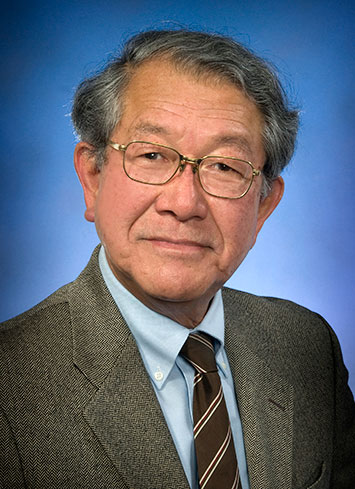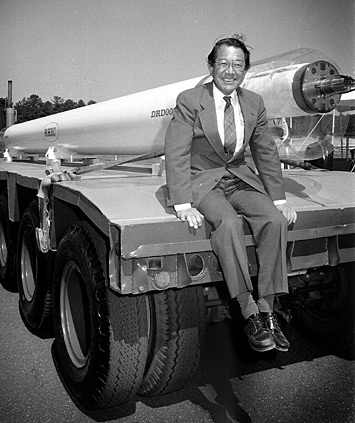Satoshi Ozaki Named Senior Scientist Emeritus
The Emeritus position at BNL was established to recognize retired scientists who have made particularly noteworthy contributions to the Laboratory's reputation as a world-class scientific institution
January 24, 2013

Satoshi Ozaki
Satoshi Ozaki, who after a long and distinguished career at Brookhaven Lab retired on December 31, 2012, has been named Senior Scientist Emeritus.
Ozaki joined BNL in 1959 with a master's degree in physics from Osaka University, Japan, and a Ph.D. in physics from the Massachusetts Institute of Technology. His work in experimental particle physics and large scale detector development at Brookhaven led to an 1981 invitation from the National Laboratory for High Energy Physics, KEK, in Japan to direct the construction of TRISTAN, the first major high-energy particle collider in the country. Under Ozaki, this $500-million project was completed on time and within budget to start operations in 1987, accelerating and storing beams of electrons and positrons at 30 billion electron volts — the highest energy in the world at the time. In 1989, Ozaki returned to BNL to head the Relativistic Heavy Ion Collider (RHIC) project, and more recently, to work on the National Synchrotron Light Source II (NSLS-II).
On his retirement, Ozaki was congratulated and thanked for his distinguished service by then-Laboratory Director Sam Aronson, who noted,
"Throughout your career, you have made lasting, impactful, and substantial contributions to the Laboratory and the Department of Energy. Your work on the TRISTAN accelerator in Japan, as head of the RHIC project, and as director of the Accelerator Systems Division for the NSLS-II project have been essential to the realization of these major machines for fundamental science. Your dedicated and inspired leadership in taking the RHIC project from concept to reality continues to earn tremendous dividends on the Department of Energy's (DOE) investment in RHIC. The impact of RHIC on the international nuclear physics community, science, and society is enormous, as you know.

Satoshi Ozaki in 1991 with a yet-to-be-installed magnet for the Relativistic Heavy Ion Collider.
"In addition to these roles, you have been absolutely essential in establishing Japanese support for projects at the Laboratory, including support for the PHENIX detector at RHIC and the RIKEN BNL Research Center. The DOE, as well as many other international organizations hold you in high regard for your expertise and judgment, and your service on advisory and review committees is invaluable.
"Your accomplishments have been recognized with prestigious awards from the IEEE Nuclear and Plasma Sciences Society, the American Physical Society, and the Consul General of Japan. We would like to join them in recognizing you for your contributions to science on two continents, and especially here at Brookhaven National Laboratory."
Said Ozaki, "I sincerely thank Dr. Aronson for the commendation above and the Laboratory for this recognition of my contributions by granting me Senior Scientist Emeritus status. Looking back at my 45 years of tenure at BNL that began in 1959 and was interrupted for nine years while I was at KEK in Japan, BNL has been very good to me. The Lab has provided me with many opportunities for exciting scientific, technical and managerial endeavors. In the early years, challenges included frontier high energy physics experiments at the newly commissioned AGS, and in particular, the world's first experiment in 1963 with an online computer for real-time data analysis. In the 1970s, I had an opportunity to manage the On-Line Data Facility (OLDF) that provided online computing support for a number of experiments at the AGS, as well as to design, build and manage the Multi-Particle Spectrometer (MPS) on the AGS floor as a user facility.
"After returning from Japan, the RHIC project challenged me to solve a number of technical issues as well as persistent financial difficulties. Nevertheless, the project was completed without delay. With steady performance improvements by our able Collider-Accelerator Department, RHIC is a highly productive workhorse for BNL and our nuclear physics community. After RHIC, I was very fortunate to work on a conceptual design of the BNL site-specific neutrino factory based on a muon storage ring, and to engage in other accelerator-related activities such as the International Linear Collider effort. I was very pleased to help the NSLS-II project when it began in 2005 by organizing its Accelerator Systems Division and advancing the design for the accelerator system. Although this was my last major undertaking, I plan to continue with the project even after my formal retirement.
"I would like to take this opportunity to thank successive directors of the Laboratory for their trust in me and support for my endeavors. I also thank my colleagues for their friendship and advice, and supporting staff in my team as well as outside for their dedication and hard work over the many decades. I am also grateful to my wife, Yoko, for her understanding and lifelong support."
2013-3577 | INT/EXT | Newsroom









